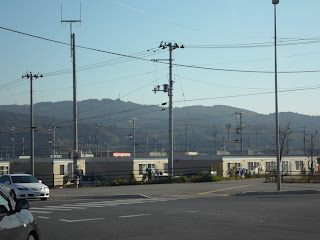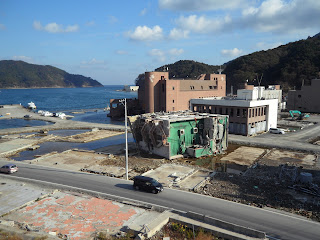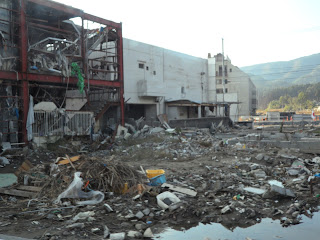 | |
| One of the main problems now in Japan is where to put all of the debris from the devastation. This is one of many garbage dump mounds located in Sendai. |
 |
| A different garbage mound in Sendai. |
 |
| One of the buildings near the house I volunteered at that has noticeable damage from the tsunami. |
 |
| A coca-cola machine that was damaged from the tsunami. |
 |
| If you look close you can see that this wall has been destroyed from the power of the tsunami. |
 |
| These homes where not picked up by the tsunami, but the destruction to the homes made them damaged beyond repair so they had to be torn down. |
These pictures were all taken in Sendai, but the next set of images were taken as the van that I was riding in drove closer to the sea. The destruction quickly changed from holes in walls and cracks to multiple buildings torn apart, debris all around and whole neighborhoods destroyed. Our destination was a sea port town called "Ishinomaki" and it used to be a thriving town. This town was one of the hardest hit from the tsunami. Standing in what remained of this town is something I will never forget.
 |
| The beautiful sea scape that is a reminder that the sea is both beautiful and destructive. |
 |
| This is a rail road that runs next to the sea. It is the same road that connects Sendai to Ishinomaki. Here the tracks and the road both had to be reconstructed because of heavy damage. |
 |
| All of these foundations once housed a building. |
 |
| I was told that the water should not be this far inland.. |
 |
| The roads here had to be built up after the tsunami since it had sunk into the ground. |
 |
| Ishinomaki is now an empty land of concrete that is just a reminder of what once stood here. |
 |
| Out in the distance the land rises and you can see homes that have damage but are still standing. |
 |
| Another building that has been thrown onto its side by the power of the tsunami. |
 |
| In the city of Ishinomaki lies a stretch of land that houses the mounds of debris. |
 |
| These mounds were so large that as the Van I was in drove by the mounds on both sides of the van engulfed us.They must have been two to three stories high |
 |
| If you look close you can see the cars among the debris. |
Its was very powerful to stand in the midst of this destruction. Your thoughts comb over what remains of the landscape and the terrifying thoughts of those that lost their lives. Emotion overflows your body in such a way that it is hard not to cry. The thoughts of putting yourself in this same spot on the day that the tsunami hit forces you to think about how fragile life really is. I know that I watched the events unfold on TV and online as it happened in America but this is on a different level. Actually seeing for yourself and standing amongst the rumble and destruction. It also reminded me of the feelings I have from September 11th when I was in high school. I can still vividly remember crying in the car with my mother at the moment I heard the first plane hit the twin towers. I am not saying that the disaster of September 11th is the same as march 11th but what I am saying is it is my way that I relate to the question that Japanese people ask each other. Where were you when it [the tsunami] happened?
At the same time that I see and hear of this devastating blow to Japan I also see the goodwill that has come out of the destruction. The heroic and brave people who did all they could to help others in this crisis before they died. All of the people who rushed to Japan to help volunteer and find people trapped and to clear debris. People from around the world that showed support through donations and letters of love. Seeing the strength of people who have lost everyone in their families yet they live on for them. Again my heart goes out to all who were affected both in mind and body from this horrible disaster.




































No comments:
Post a Comment